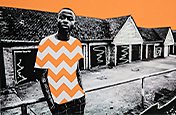Brand Identity: What it is and How to Craft a Unique One
When you think of a major brand like Coca-Cola or Apple - what do you think of? You might think of a glass bottle of Coke in the fridge or an iPad on your bedside table. Or maybe you think of a logo, TV advert or social media post you saw this morning.
Perhaps you think of something a bit more abstract. Coca-Cola is authentic and timeless - the ‘Real Thing’. Apple is sleek and creative - it ‘Thinks Different’. These overall impressions are part of a strong brand identity - the sum total of how a business advertises, markets and presents itself to the public.
In this guide, we’ll cover how to craft an effective brand image through graphic design techniques, along with providing some successful examples to help inspire you.

What is brand identity in graphic design?
If a brand is the face of a small business, then a brand identity is its personality. It’s the visual and verbal manifestation of what you do and what you stand for.
To create one, you’ll need to combine your traditional branding graphic design key elements like logos, visual assets and colours with brand storytelling and TOV. The aim is to ensure your marketing and advertising is totally in sync with your brand values and audience - whether you’re sending a thank you email or launching a flashy ad on TV.
This is important. Balancing the different touchpoints of a brand is the difference between a consistent brand identity and a disjointed one that people may distrust or dislike.
You can think of it a bit like a person’s identity. Individuals aren’t just made up of names and faces. Instead, they have a way they talk and act too. They have opinions, beliefs and a story of their own.
When you bear in mind that major brands often employ tens or even hundreds of thousands of people, you can see how a strong brand identity is a crucial standard to rally behind.
Why is brand identity important?
A strong brand identity can help you to attract and retain customers. Here are a few ways it can make a difference:
- Establishing trust. A strong, consistent brand identity demonstrates authority and professionalism. It also shows that you know your audience, speak their language and understand their priorities.
- Providing a visual. Consistent, logos, colours, typography and imagery help put a ‘face’ to a business. Without this, an organisation can feel abstract and ill-defined.
- Landing new customers. Your adverts and brand storytelling are the hook that reels in customers. Get it right and you could create a lasting relationship. If you come across as inconsistent or insincere, you might alienate them.
- Providing consistent service. With a consistent brand identity, you can make an impact at every step of the customer journey - from a social media post or TV ad that makes a first impression, to a routine email invoice to an existing customer.
- Building a stronger team. Brand identity isn’t just about customers - but staff too. If your staff believe in your brand and its messaging, they’ll help you to deliver your vision more effectively.
- Rebranding. If you want to appeal to the public five, 10 or 20 years down the line, you might need to move with the times. A strong brand identity can help you to nail a rebrand with less turbulence - showing that you’re the same brand your customers already know, just with an upgraded look and feel.
How to create a brand identity
Creating a successful brand identity is a long process - and it’s not always easy to launch a new brand name as a fully-formed entity. Let’s take a look at the steps you need to take on your branding strategy:
Approaching the brand identity design process
Before you start thinking about logos and tones of voice, you’ll need to carefully consider your brand and its audience.
Build a brand proposition
First, think about what your purpose is. Why do you sell products? Why should audiences choose you in a crowded marketplace? Beyond simply selling products or services, what are your ambitions? What is your brand positioning in the market? In short, what do you stand for?
From here, you can start to craft a mission statement - this will inform your brand identity. Here are a few examples from Patagonia, IKEA and InvisionApp:
- Patagonia: Patagonia is in business to save our home planet.
- IKEA: To offer a wide range of well-designed, functional home furnishing products at prices so low that as many people as possible will be able to afford them.
- InvisionApp: Transform the way people work together by helping them to collaborate better. Faster. On everything. From anywhere.
From there, we can think about the next stage - audience.
Establish and analyse your audience
Visual branding - like logos, typography and colour schemes - isn’t just the whims of brand identity graphic designers - they typically come through stringent audience research. If you don’t have an idea of who your audience is or how to reach them, then your brand identity could fail to resonate with your target audience.
So, how do you start whittling down your audience?
A good place to start is with buyer personas. This is a rough sketch of the demographics, preferences, opinions and pain points of your ideal customer.
Let’s look at an example of how to create a buyer persona:
- Gather customer insights: Start collecting customer data through internal sources like sales records and social media. Analyse feedback to understand customer priorities and pain points. You could even conduct external research in the form of surveys and interviews to further enrich your customer insights. Here you can really get to know your audience.
- Segment your customer base: Now you know who your customers are, you need to divide them into segments. This means grouping your audience based on your collected data. This could be by age, location, gender, behaviours etc. Prioritise key segments and assign descriptive names to each group.
- Craft buyer personas: For each segment, create detailed buyer personas using demographic data, characteristics, goals, behavioural patterns and challenges. This will give you a comprehensive picture of who your customer base includes, where they are, how they interact with your business and what they care about socially, politically and personally.
Buyer personas can help you to think about how your brand may be perceived by your audience. It can provide some ideas on how you can tailor your brand identity to resonate with them effectively and build customer loyalty.
You’ll also need to look at the competition. What are other businesses in your industry doing well and what could you do better? Are they speaking the language of your audiences? This market research stage is also an opportunity to identify topics that are important to your users.

Create a brand personality
Now you have a good idea of the age, demographics and psychology of your target market, you can start tailoring your brand to meet them. Here, you’ll need to think carefully about what makes your brand unique.
A good way to do this is by creating core traits. Focus on simple, clear adjectives: ‘sustainable’, ‘down-to-earth’ or ‘friendly’ are good places to start. Make sure to keep them attainable and authentic to your brand, as well as relevant to your audience.
Now you know the traits of your brand, you can start building a personality statement. This should be clear, specific and easy to understand. Focus on the way your brand acts, communicates and presents itself. Something like:
“Fast fashion is no longer a viable model in the climate crisis. We offer sustainable style at down-to-earth prices. Our shops are friendly, fun and inclusive spaces where people can create new looks from pre-loved pieces - and we’re always on hand to help”.
Develop a consistent brand identity
Now you’ll need to think about the visuals and tone that make your brand stand out. Often, this starts out with a mood board - this can be digital or you can get some magazines, scissors and drawing pins at the ready. Find examples of images, colours, headlines or textures and pin them to a board. There are no rules here - just find things that inspire you.
After you’ve created your mood board, what impression does it give you? Have you chosen a range of tasteful, muted colours or a zany collection of fluorescents and neons? Think about how your colour choices will help craft your visual identity. How will this affect your audience - will it make them calm, excited, stressed, anxious?
Again, put yourself in your audience’s shoes and think about the sorts of colours that would make your customers buy your products. From there, you can set about making a brand colour palette. If you want to dig deeper, we’ve got a great guide to colour theory to help.
Of course, your brand doesn’t start and end with colour schemes. You’ll need to take a similar approach to typefaces, imagery, logo design and even language and even to help you to inform your brand.
- Brand fonts are crucial to creating a consistent graphic design brand identity across your marketing and comms. If you’re pitching to a younger, less formal audience, you might choose a throwback 70s-style font. A B2B audience may like a direct, clear sans serif. And if your audience is more traditional, they’d expect a traditional serif font. Choose two complementary fonts and use them in headings and body text.
- Logos are the face of your brand. You’ll need a logo design that complements your values, speaks to your audience and fits with your other style choices. Check out our guide to designing a logo to find out more.
- Imagery is the kind of photos, graphics and visual styles you use. Do you go for fun, doodle-like scribbles or glossy lifestyle imagery in your marketing materials? Do you use tints and shadowing on headlines or flashing graphics and GIFs on emails?
- Brand TOV is the language you use to communicate. Dig into the personality of your brand and how you want to speak to your audience. You might choose a casual style with plenty of chattiness, slang and contractions. Or you might choose a courtly formal style. Whichever you choose, make sure you’re clear and consistent with it.
Setting out brand identify guidelines
You need to ensure consistency in your brand identity - and this is where brand identity guidelines come into play. Here, you can create rules and regulations for all visual elements used in your marketing, advertising and communications.
Break down your guidelines using all the factors we covered above - fonts, logos, language, the works. Don’t forget to sell the ideas behind the choices in your guidelines, rather than simply setting out a dry process document. The best brand guidelines are fun to read.
Templates are another great way to go. Using Adobe Express, you can set out templates for email comms, social media posts and all the other regular communication channels. Add key visual style elements, plus other components that your staff can update as they choose.

Analysing the impact of your branding strategy
Now, you should be pretty much ready to launch. But don’t forget - branding strategy is an iterative process. It’s important to measure success and makes tweaks as prn go along. A few ways to do this include:
- Measure social media awareness. Some social media platforms help you measure mentions and sentiment in your brand. Keeping an eye on your mentions and checking up on comments and reactions can help you to understand where your brand might be missing or hitting the mark.
- Review website traffic. Tools like SEMrush, ahrefs and Google Analytics can help you to measure the traffic coming into your site. This can aid you in measuring the success of digital and email campaigns.
- Analyse NPS scores. Net promotor scores are customer surveys that brand use to measure customer sentiment. How likely are your customers to recommend you to a friend or colleague?
- Keep track of your marketing efforts. A wide-ranging digital marketing strategy can also help you to keep up with the success of your brand. Here, you can work out which pages, posts and more have resonated with your audience.
Graphic design brand identity examples
- Coca-Cola’s taglines are often based around ‘realness’. And its red logo, unique, script-like typeface and confident tone of voice speak confidently of this authenticity and timelessness. With their brand identity, Coke sells an experience that you can’t get with other brands.
- Innocent drinks take a light-hearted tone. Their lowercase font and doodle-like logo create a sense of childlike naivety - and they go hard on quirky humour and simple language in their brand TOV.
- Apple’s Think Different slogan, sleek logo and product placement in popular media lend it a sense of aspiration, quality and creativity the world over.
- Compare the Market balance key principles of clear, accurate and expert financial guidance with their irreverent and longstanding ‘Compare the Meerkat’ logos and advertising campaigns. The result aims to make complex consumer and financial topics ‘simples’ for users.
- Slack use an informal tone and sleek creative approach to make business messaging feel dynamic, engaging and decidedly un-corporate. Its rounded sans serif font and friendly waving hand emoji feel welcoming to all users.
Brand identity FAQs.
What should brand identity include?
A brand identity includes branding elements like logos, colour palettes and fonts, as well as communication style, brand tone of voice and more. A brand identity is the overall impression your brand gives to the public - like a personality.
Do I need a brand identity?
Businesses need a strong brand to be engaging to customers and stand out from the crowd. Your brand identity ensures that your business remains consistent in the way it acts and communicates - maintaining brand values, a TOV and a creative approach that resonate with the right audience.
What’s the difference between a brand identity and a logo?
A logo is just one part of brand identity. Brand identity goes further than traditional branding to encompass brand TOV, social media and much more. It’s about crafting a personality that resonates with your audience - from the way your brand looks, to the way it sounds, acts and communicates.
Craft your brand identity with Adobe Photoshop
Want to start crafting your own brand identity? We’ve got plenty of resources to help. Check out Photoshop to learn, design and build a brand from the ground up.
You might also be interested in…
Set a mood with secondary colours.
In this secondary colours beginner's guide, discover how different colour combinations can help you to make a splash with attention-grabbing work.
Add complex watercolour textures to your digital paintings.
Learn how background textures can bring depth to digital watercolour paintings.
Create professional-quality backgrounds for any kind of media.
Discover how to craft professional-quality backgrounds for presentations, desktops and other projects.


